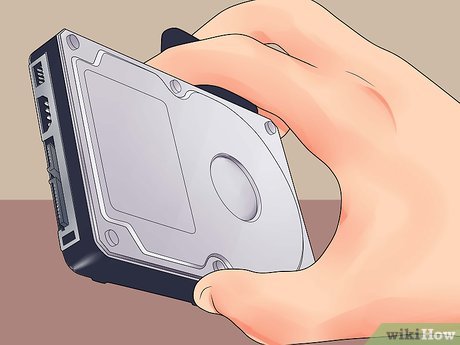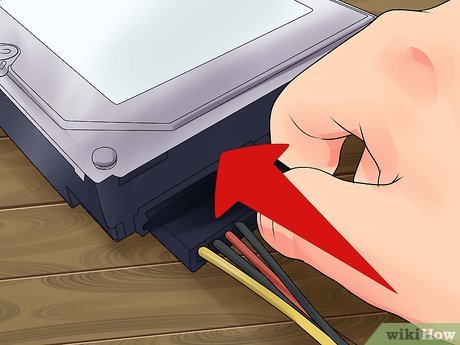How to Repair a Physically Damaged Hard Drive
Determine hard drive status
 How to Repair a Physically Damaged Hard Drive Picture 1
How to Repair a Physically Damaged Hard Drive Picture 1
Check for damage. Check to make sure the drive is completely damaged by looking at possible reasons why the hard drive cannot be recognized by the computer.
If the drive makes a loud and steady clicking sound, stop and move on to part two. This means the hard drive is completely damaged.
 How to Repair a Physically Damaged Hard Drive Picture 2
How to Repair a Physically Damaged Hard Drive Picture 2
Check hardware connection. These locations are the best places to start looking at. If the problem lies here, the fix will be very quick and inexpensive!
Check to make sure the computer is still connected to a power source. If the plug or cable is accidentally dropped or damaged by a mischievous cat, the system will stop working.
Open the computer case. Are the power and data cables (IDE or SATA) securely plugged in and in place? These cables must be in the correct position, and there must be no bent, broken or damaged pins.
 How to Repair a Physically Damaged Hard Drive Picture 3
How to Repair a Physically Damaged Hard Drive Picture 3
Observe the whole thing at once. Sometimes it's not the drive that's the problem, it's the PCB that controls the operation underneath. If the problem is caused by the power supply or component failure on the printed circuit board, the drive will definitely stop working because it is not being operated.
Look for signs of damage such as wear or burns. If you see these marks, rest assured because you can fix them relatively easily.
If you want to replace the PCB board, you can Google parts for the drive model and manufacturer.
Before proceeding, you need to remove the old circuit board (fixed with 5 screws, remember to keep them carefully!).
Slide out the old drive and replace the circuit board with a new one. Avoid touching the metal wires on the new circuit board because static electricity can damage everything before you can use it. You can ground yourself by wearing an anti-static bracelet, touching metal or something lying on the ground (or the inside of the computer while plugged in).
Install the new circuit board into the drive securely, then tighten the screws to secure.
Reconnect the drive to the computer and then turn on the power. If the drive works, you've succeeded. You can proceed to back up your data at this time.
If it doesn't work, keep looking.
 How to Repair a Physically Damaged Hard Drive Picture 4
How to Repair a Physically Damaged Hard Drive Picture 4
Check if the drive is recognized or not. If everything is in place and still nothing appears in the controller PCB, go to Windows Disk Management, BIOS, or Mac OS X Disk Utility to see if the drive is recognized.
Repair options
 How to Repair a Physically Damaged Hard Drive Picture 5
How to Repair a Physically Damaged Hard Drive Picture 5
Option: if this data is important, you will need to find a professional hard drive recovery company and pay them to restore the data. If you do the repairs yourself, the odds of being able to recover data professionally are almost nil.
 How to Repair a Physically Damaged Hard Drive Picture 6
How to Repair a Physically Damaged Hard Drive Picture 6
Do a quick Google search for "hard drive replacement parts" to see a few different directions. Replacing parts may work for older devices, but not modern hard drives.
 How to Repair a Physically Damaged Hard Drive Picture 7
How to Repair a Physically Damaged Hard Drive Picture 7
Fix it yourself. The method favored by courageous and technically minded souls is DIY. This method is promoted by companies specializing in providing removable components with the view that if you just replace the burned control board, the hard drive will work again.
Actually this possibility exists. The biggest risk, however, is this: the ICs on control panels are increasingly calibrated specifically for the specific drive, so there's no guarantee that a replacement will work. Either way, this is the least expensive option.
 How to Repair a Physically Damaged Hard Drive Picture 8
How to Repair a Physically Damaged Hard Drive Picture 8
Get professional help. This is the ONLY option to bring the drive back to life, or at least recover the data on it (your ultimate goal).
This solution is sometimes faster than repairing it yourself, and the success rate is also higher, but you will have to pay a fee. As long as the data is important, these costs may be worth it.
It's even possible that you will have to pay two to three times the price of the original hard drive, so consider the cost with the value of the data on the drive.
Fix it yourself
 How to Repair a Physically Damaged Hard Drive Picture 9
How to Repair a Physically Damaged Hard Drive Picture 9
Please read this first. If the hard drive makes a clicking sound from the beginning, each time you connect it, more data will be lost because the magnetic layer on the drive is gradually failing. Do not repair it yourself if the data on it is important to you for work or legal reasons . Some of these techniques are a fluke, with a 50:50 success to failure ratio. This means that if luck does not smile, the parts of data that have not been affected will not fly away.
 How to Repair a Physically Damaged Hard Drive Picture 10
How to Repair a Physically Damaged Hard Drive Picture 10
Conduct a physical inspection. Hold the drive in your hand and rotate it back and forth, while listening to the sound (if any). At first it may seem like you're "doing nothing", but if there are actually any loose parts, this operation can "ruin the flour and spoil the sugar"! If you don't hear any sound, especially if the hard drive is old or hot, the problem is most likely with the spindle or coil. Consider this risk before proceeding with the next steps: if you disassemble the drive, data that can still be salvaged will likely be completely damaged.
 How to Repair a Physically Damaged Hard Drive Picture 11
How to Repair a Physically Damaged Hard Drive Picture 11
Warm up the hard drive. Preheat the oven to the lowest setting for about 5 minutes, then turn off the oven. Place the hard drive in the oven for 2-5 minutes until it warms up. Note: even if you don't know if the hard drive is still usable or not, it's likely that this will cause it to be completely damaged.
Take out the drive and repeat the first step. If you still don't hear any sound, proceed to the next step. However, if there is a difference, you need to insert the drive into the computer, listen for the usual spinning and clicking sounds that indicate the hard disk is working. If everything seems fine, you can access the drive and transfer the data to another, better drive.
If necessary, warm the drive again, then hold the drive in your hand, spin it quickly, and tap it on a hard surface. This method will help free the stuck hard disk (if successful). Otherwise, by now, you have ruined what could have been saved in the beginning.
Repeat the first step. Do you hear the hard disk moving? If so, insert the drive into your computer and try accessing it again.
If you hear a steady "clicking" sound with each movement, the hard disk is probably no longer stuck. Check to see if there are any rattling sounds when you gently rotate the drive back and forth through 90-degree angles. If so, this is a sign that the components inside the drive are loose and disconnected, this case is beyond the scope and purpose of the article.
 How to Repair a Physically Damaged Hard Drive Picture 12
How to Repair a Physically Damaged Hard Drive Picture 12
Cool the hard drive. Another controversial option is freezing the drive. This is a last ditch effort to get the drive working again, long enough for you to copy important files. If nothing has worked so far, this method is worth a try.
Place the drive in a zip-lock bag and suck out all the air. Place the drive in the freezer for a few hours.
Insert the drive back into the computer and try accessing it. If the drive still doesn't work, turn off the computer, remove the hard drive and hit it on a hard surface like a table or floor. Then, reinsert the drive and access it again. If successful, you can quickly save the data and then throw away the hard drive. If not, then you have tried your best and the only option is to seek professional help.
Professional repair
 How to Repair a Physically Damaged Hard Drive Picture 13
How to Repair a Physically Damaged Hard Drive Picture 13
Refer to reviews to find a reputable address. There are many companies that provide drive repair services at a low cost. Before using the service, find out the information and experience of a certain company through user forums, or discuss directly to see what the recovery rate is.
Check for credibility, and ask what the costs will be for both successful and unsuccessful cases. If successful, you will probably be happy to pay, but if recovery is not possible, is that fee reasonable for you?
No one wants to lose money when they receive nothing, however, the service provider also spent time and expertise to process it so they need to be paid.
You should read it
- How to Repair Bad Sectors
- How to Recover Data from Broken Laptop Hard Drive
- How to identify hard drive failure, hard drive failure, bad hard drive on Windows
- What is a hard drive? There are several types?
- Dissection of hard drive components
- Pros and cons of using an external hard drive for PS4
- 5 ways to check hard drive effectively to help periodically check the hard drive
- Know about bad sectors on your hard drive
- Learn about HDD hard drive
- 5 hard drives with the best reliability
- Computer hard drive is fast, why?
- Microsoft makes glass hard drives that last 10,000 years






 How to Repair Bad Sectors
How to Repair Bad Sectors How to identify hard drive failure, hard drive failure, bad hard drive on Windows
How to identify hard drive failure, hard drive failure, bad hard drive on Windows Repair-bde command in Windows
Repair-bde command in Windows How to Recover Data from Broken Laptop Hard Drive
How to Recover Data from Broken Laptop Hard Drive Fix Mac hard drive with Disk Utility's First Aid feature
Fix Mac hard drive with Disk Utility's First Aid feature Warning signs of hard drive failure you need to pay attention to!
Warning signs of hard drive failure you need to pay attention to!